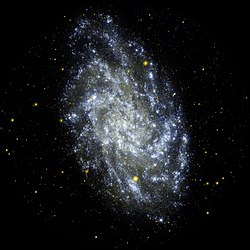Triangulum galaxy
The Triangulum galaxy is a spiral galaxy approximately 3 million light years (ly) from Earth in the constellation Triangulum.[1] The Triangulum galaxy is the third-largest member of the Local Group of galaxies,[2] which includes the Milky Way galaxy, the Andromeda galaxy and about 50 other smaller galaxies. It is one of the most distant permanent objects that can be viewed with the naked eye.
It is catalogued as Messier 33 or NGC 598, and is sometimes informally referred to as the Pinwheel galaxy, a nickname it shares with Messier 101.
Properties
Structure
In the French astronomer Gérard de Vaucouleurs' revised Hubble Sandage (VRHS) system of galaxy morphological classification, the Triangulum Galaxy is classified as type SA(s)cd. The S prefix says that it is a spiral galaxy. The A is assigned when the center of the galaxy lacks a bar-shaped structure, unlike SB class barred spiral galaxies. American astronomer Allan Sandage's "(s)" notation is used when the spiral arms emerge directly from the center, instead of an inner ring like an (r)-type galaxy. Finally, the cd suffix describes the openness of the arms. cd means loosely wound arms.
This galaxy has an inclination of 54° to the line of sight from the Earth, allowing the structure to be examined without significant obstruction by gas and dust. The disk of the Triangulum Galaxy appears warped out to a radius of about 8 kpc. There may be a halo surrounding the galaxy, but there is no bulge at the center. This is an isolated galaxy and there are no indications of recent interactions with other galaxies, and it lacks the small following galaxies or tidal tails associated with the Milky Way.
Triangulum is classified as unbarred, but another look at the galaxy shape shows a weak bar-like structure around the galactic nucleus. The center of this galaxy is the most luminous source of X-rays in the Local Group of galaxies. However, the center does not appear to contain a supermassive black hole, as an upper limit of 3,000 solar masses is placed on the mass of a central black hole based upon the speed of stars in the core region.
The inner part of the galaxy has two spiral arms, along with multiple spurs that connect the inner to the outer spiral features. The main arms are called IN (north) and IS (south).
Triangulum Galaxy Media
Triangulum (M33; lower left of center) and Andromeda Galaxy (M31; above center)
NGC 604, a star-forming region in the Triangulum Galaxy, as imaged by the Hubble Space Telescope
NGC 604 in the Triangulum Galaxy
References
- ↑ Brunthaler, Andreas; et al. (2005). "The geometric distance and proper motion of the Triangulum Galaxy (M33)". Science. 307 (5714): 1440–1443. arXiv:astro-ph/0503058. Bibcode:2005Sci...307.1440B. doi:10.1126/science.1108342. PMID 15746420. S2CID 28172780.
- ↑ Karachentsev I. D.; et al. (2004). "A catalog of neighboring galaxies". Astronomical Journal. 127 (4): 2031–2068. Bibcode:2004AJ....127.2031K. doi:10.1086/382905. S2CID 124129428.






